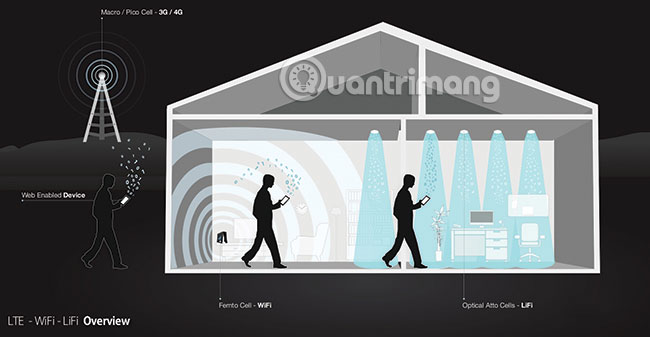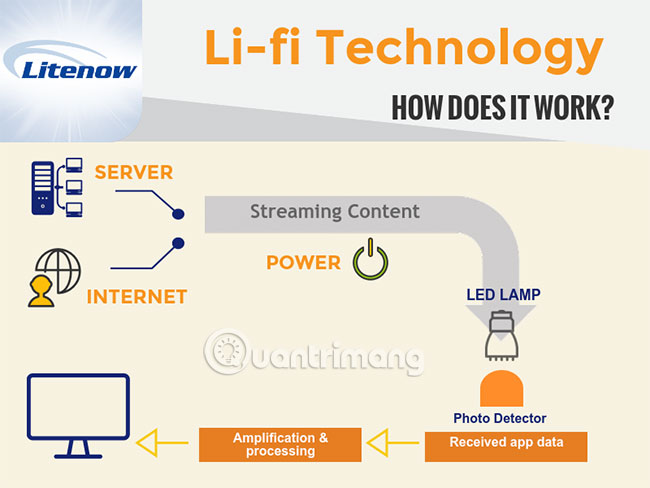What is Li-Fi?
Can you imagine a movie from . light bulbs? With Fidelity Technology (Li-Fi), a new wireless technology, you can do it. Li-Fi uses both infrared and visible light spectrum for high-speed data transmission. Unlike WiFi, which uses radio signals to send information, Li-Fi uses light-emitting diodes (LED bulbs) to transmit data.
Learn about Li-Fi technology
- What is Li-Fi?
- What about 5G?
- How powerful is Li-Fi technology?
- How does Li-Fi work?
- Li-Fi fixes common security issues in WiFi wireless connection
- Li-Fi eliminates noise
- Li-Fi technology requires constant access to the light source
- Hardware requirements will make a big change in the light bulb market
What is Li-Fi?

Although Li-Fi sounds strange and rare, in fact, you have used this Li-Fi technology every time you click on the TV control. The term Li-Fi was first used by University of Edinburgh professor Harald Haas in 2011 in TEDGlobal, when he asked the question: "What if all the light bulbs in the world can transmit data? " He explains how flashing light from an LED, can transmit data more efficiently and safely than cellular towers. Professor Haas continues to set up a company to develop Li-Fi technology, called purLifi, to create a simple system that works with USB devices.
LED bulbs are used in Li-Fi network containing chips, technology for signal processing, making light flashing, similar to strobe light lamps (flashing lights often used for stage). This fast continuous blur of the human eye will not be detected, used to generate electrical signals by Li-Fi receivers and data transmissions. LED bulbs are very suitable for Li-Fi, because unlike fluorescent lamps and incandescent lamps, LEDs have high intensity, necessary conditions for data transmission at great speeds.
What about 5G?
5G is the name given to the latest mobile connectivity, giving better performance speeds than 4G (LTE / WiMax), 3G (UMTS) and 2G (GSM) systems. 5G wireless devices transmit data by radio with a local antenna array and low power automatic receiver. Local antennas are connected to the telephone network and the Internet by high bandwidth.
5G is 100 times faster than 4G. This increase in performance is achieved by using invisible radio waves with higher frequencies. In contrast, 4G, 3G and 2G networks use lower frequencies in the microwave range. Unlike 5G networks and earlier versions, Li-Fi uses radio waves in the visible spectrum, fast and has much larger bandwidth.
How powerful is Li-Fi technology?
Li-Fi transmits data at 1GB per second, 100 times faster than regular WiFi. By using infrared and visible light spectrum, Li-Fi is about 2600 times larger than the entire 300GHz radio frequency spectrum.
In contrast, WiFi has a limited number of radio bands. This is important when families and businesses buy wireless devices, as well as rely on Internet of Things (IoT) technology.
This increase in demand makes it more difficult to move data across a limited number of bands. Some sources said that by 2020, more than 50 billion devices will always be connected to the Internet, combined with the fact that 5G requires a large amount of large radio spectrum. Pushing this huge demand to Li-Fi will release more radio spectrum, helping to handle the rapidly growing Internet traffic.
How does Li-Fi work?

With Li-Fi processing chips, LEDs become network access points. Binary data streams are provided from the Internet or the server via high-speed media and routers, then to lights. The LED router then adjusts the output to embed data into the light. Your device will need an optical receiver, or a dongle plugged into a USB port, to access Li-Fi.
Li-Fi fixes common security issues in WiFi wireless connection
Light can be secured in a physical space. Just like controlling a TV that cannot penetrate a wall, Li-Fi's range of activity is limited by walls, floors and other physical barriers. This makes it harder for hackers to access your Internet. This limited range makes Li-Fi suitable for sensitive applications, such as in the military and healthcare industries.

Li-Fi eliminates noise
Many users can use the same Li-Fi bandwidth without interference, because Li-Fi does not show any electromagnetic interference. This makes it possible to connect to the Internet in areas where using WiFi becomes dangerous, making it suitable for chemical or nuclear plants.
Li-Fi can provide Internet access in inaccessible radio areas, such as in the subway, underwater and on airplanes.
Li-Fi technology requires constant access to the light source
Lights must be turned on for Li-Fi to work. Li-Fi requires a straightforward, obstacle-free connection, like a TV control. Your device will always need an unobstructed line with the Li-Fi transmitter, which can be difficult if you use a mobile device while you're on the move.
Hardware requirements will make a big change in the light bulb market
It must be convincing that the bulb manufacturer adds that adding a circuit to the LED bulb (allowing the bulb to flicker) is worthwhile to increase production costs. In addition, the Li-Fi network will require Internet cables to run to LEDs as part of the network.
 What is TikTok and how does it work?
What is TikTok and how does it work? What is GoDaddy?
What is GoDaddy? What is Android TV Box?
What is Android TV Box? All cmd and dos commands on Windows
All cmd and dos commands on Windows Learn about the new drawing app for iPad Adobe Fresco
Learn about the new drawing app for iPad Adobe Fresco What is the Menu key? And how to remap it?
What is the Menu key? And how to remap it?